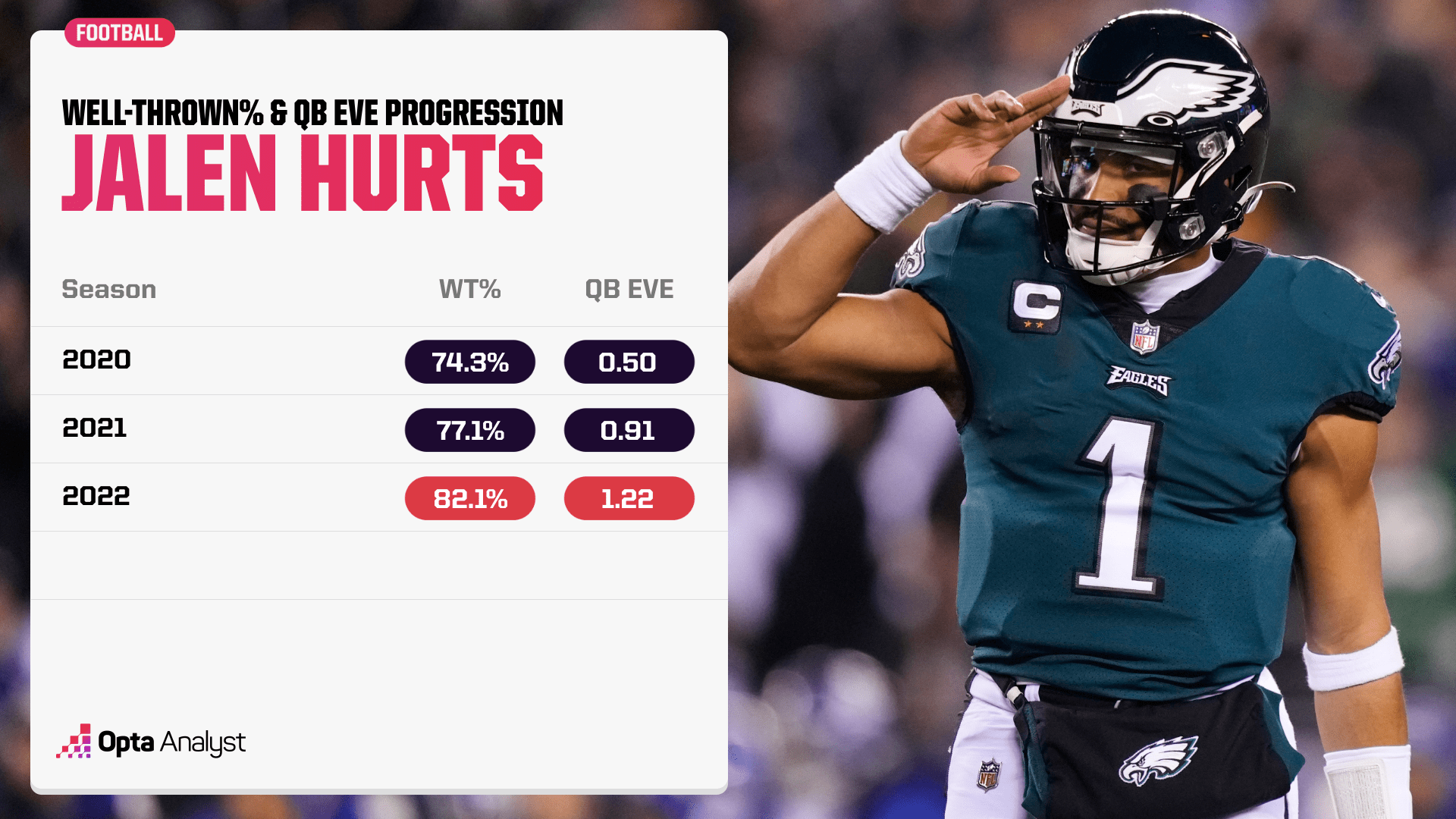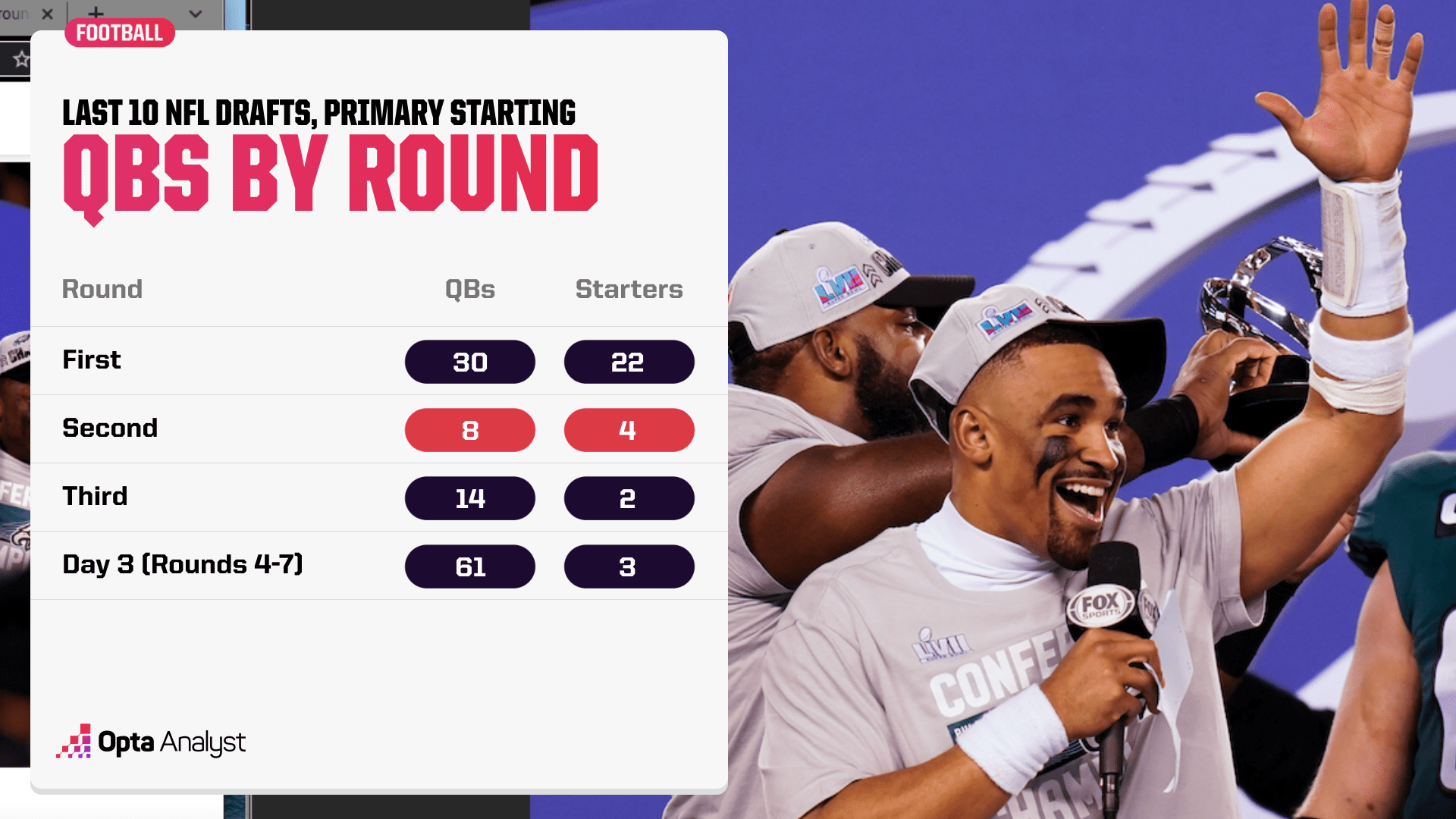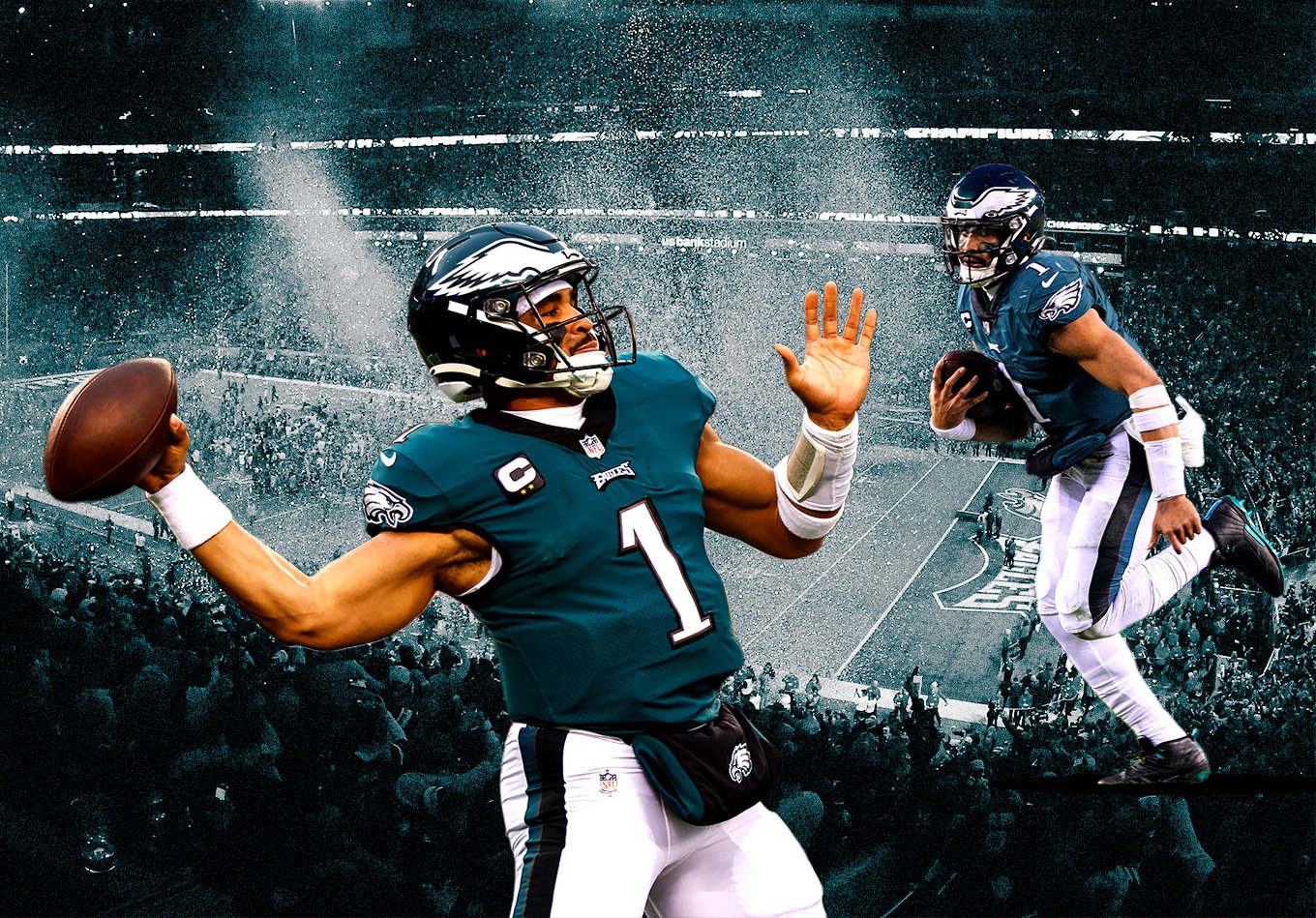If you’re looking to have some fun over the next week and a half before the Philadelphia Eagles take on the Kansas City Chiefs in Super Bowl LVII, go back and look at some of the immediate reactions after Jalen Hurts was selected in the second round of the 2020 NFL Draft.
Very, very smart people hated and couldn’t wrap their minds around Eagles general manager Howie Roseman’s decision to take a quarterback on Day 2 of the draft when Philadelphia already had 2016 No. 2 overall pick Carson Wentz signed to a four-year, $128 million contract extension through the 2024 season.
There was speculation that Hurts could be used as a gadget player similar to Taysom Hill and that the Eagles could even run a part-time two-quarterback system. In a series of hypotheticals, Wentz being traded a year later and Hurts leading the Eagles to a Super Bowl within three seasons weren’t among them or even in the stratosphere.
Philadelphia had its franchise quarterback. Why take a backup with a valuable pick that could have been used to upgrade a starting position?
Obviously, very, very smart people are wrong about football all the time. Just look at the offensive system setup of the New England Patriots last season for a prime example. And yes, many pundits were wrong. The Eagles’ decision to draft Hurts was prudent, and if any team knew the value of a backup quarterback, it should have been Philadelphia, which saw Nick Foles lead the franchise to its first Super Bowl championship during the 2017 season after Wentz went down with an injury.
And it seems that Roseman and the Eagles’ front office were prescient in their thinking and perhaps saw that Wentz’s MVP-caliber 2017 season (pre-injury) was a bit of an anomaly. It’s unlikely that even the Eagles could have envisioned Wentz’s career taking such a severe downturn to the point that they would trade him the next offseason and then that he would be traded again a year later and (likely) cut a year after that.
But the overall lesson here is that more teams should use picks on quarterbacks, especially those who trended in the right direction in college and possess valuable tools in the way of mobility, decision-making and accuracy. Hurts has continued to improve over the course of his NFL career, just as he did in college.
Hurts’ well-thrown percentage has improved from 74.3% in 2020 to 77.1% in 2021 and 82.1% this season. His passing EVE, which is average yards gained over the expected amount in anticipated passing situations, has increased from 0.50 in 2020 to 0.91 in 2021 and 1.22 in 2022.

It’s actually pretty rare for quarterbacks to be drafted on Day 2. Over the last 10 NFL Drafts, 30 quarterbacks have been taken in the first round. There have been just 22 quarterbacks taken on Day 2 (in the second and third rounds) and 61 taken on Day 3 (fourth through seventh rounds). Just eight quarterbacks have been taken in the second round of the draft since 2013.
There’s a theory or mindset around the NFL that if you truly believe in a quarterback, you should take him as early as possible. It’s rare for a team with two first-round picks to take a quarterback with the later selection, though Lamar Jackson is a notable exception. So, it makes sense for quarterbacks to mainly be a first-round position and for there to be an uptick in the late rounds for teams looking at a backup option.
At the same time, among those eight quarterbacks taken in the second round over the last 10 drafts, half of them have been a team’s primary starter for at least two years (Derek Carr, Jimmy Garoppolo, Geno Smith and Hurts). Drew Lock has also started 21 NFL games as a second-round pick. We’re dealing in small samples, but among the 30 quarterbacks taken in the first round, 22 have been a team’s primary starter for at least two seasons.
Among third-round selections, only two of 14 QBs have been a team’s primary starter for at least two seasons, and on the third day, only three of 61 QBs have been a team’s primary starter for at least two seasons.
It makes sense that the hit rate is higher depending on how high a QB is drafted. But there’s also a case to be made based on those percentages that more quarterbacks should be taken in the second round if the talent warrants a selection. It has to be done in the right circumstances, however, because a team isn’t likely looking at a second-round pick as a Day 1 starting quarterback, though Carr, Smith and DeShone Kizer all started Week 1 of their rookie seasons.

Last year’s draft was interesting in that only one quarterback was taken in the first round, none were selected in the second round, three were drafted in the third round and five were grabbed on Day 3. It was also a unique year in which teams clearly viewed Desmond Ridder, Malik Willis, Matt Corral, Bailey Zappe and Sam Howell as similar talents and were willing to wait until the first of that group came off the board before starting the run on second-year QBs.
It will be interesting to see how that group of QBs progresses throughout their careers. Ridder, Willis, Zappe and Howell all received starts last season. And if the 2023 season started today (it doesn’t last time I checked), Ridder, Howell and Matt Corral, who missed his rookie season with an injury, would be in competition to start for the Atlanta Falcons, Washington Commanders and Carolina Panthers, respectively.
Really, the best scenario to take a quarterback on Day 2 is when a quarterback is getting up there in age or if a team isn’t fully committed to its quarterback. The Patriots did a nice job getting value out of Day 2 quarterbacks when Brady was reaching his 40s by taking Garoppolo and Jacoby Brissett, both of whom have gone on to become starting QBs in the NFL, in 2014 and 2016.
It’s not a perfect approach, of course. The Saints received no value out of taking Garrett Grayson in the third round of the 2015 NFL Draft, Davis Webb was a miss for the New York Giants in 2017, and Mason Rudolph has thus far peaked as a backup for the Pittsburgh Steelers as a 2018 third-round pick. Time will ultimately tell on Willis for the Tennessee Titans and Tampa Bay Buccaneers QB Kyle Trask, but early returns have not been great. Hitting on a quarterback is valuable – much more so than any other position, and taking swings is a worthwhile endeavor.
Hurts is the best example of a team taking a quarterback on Day 2 even if that team has a young, established starter. It’s not a perfect comparison, but Washington took Kirk Cousins in the fourth round the same year it selected Robert Griffin III in the first round, and that worked out. The Patriots, who really do a great job of continuing to replenish their quarterback room, also selected Zappe in the fourth round one year after taking Mac Jones in the first round. It was a small sample size, but Zappe played better than Jones in 2022. It will be worth watching to see if Zappe pushes Jones at all for the starting job this spring and summer with new offensive coordinator Bill O’Brien.
There are plenty of teams in this year’s upcoming draft who might not need to take a quarterback in the first round but should at least consider it in Day 2 or beyond. The Miami Dolphins don’t know what Tua Tagovailoa’s future holds after this season’s concussions. The San Francisco 49ers, Seattle Seahawks, Detroit Lions, New York Giants, Baltimore Ravens, Tampa Bay Buccaneers, Tennessee Titans, Minnesota Vikings, New Orleans Saints, Atlanta Falcons, Green Bay Packers, Las Vegas Raiders, Washington Commanders, Chicago Bears, Los Angeles Rams, Denver Broncos, Indianapolis Colts, New England Patriots, Houston Texans and New York Jets have some questions or unsettled quarterback situations at least in comparison to the Eagles in 2020 when they grabbed Hurts.
Even teams with young established starters would be smart to consider it. The Dallas Cowboys will probably be fine with Dak Prescott at quarterback for years to come. But he wasn’t as good this season, and it’s never a bad idea to invest in a young signal-caller. The Arizona Cardinals needed a better backup when Kyler Murray went down with an injury, and he looks doubtful to start the 2023 season after tearing his ACL late in 2022. Even the Eagles could consider another QB selection since Gardner Minshew might not still be in Philadelphia next season as he embarks on free agency this March.
And there are some interesting options at quarterback this spring in the 2023 NFL Draft. Alabama’s Bryce Young, Ohio State’s C.J. Stroud and Kentucky’s Will Levis are expected to go in the first round. Florida’s Anthony Richardson very well could be a first-round pick as well, but he’d be a perfect dart throw for a team if he falls to the second round. Stanford’s Tanner McKee, Tennessee’s Hendon Hooker, BYU’s Jaren Hall and Houston’s Clayton Tune are also potential Day 2 or 3 quarterback prospects in this year’s class. Hooker, who’s already 25 years old and tore his ACL late in the 2022 FBS season, showcased high-end skills as a passer and ball carrier as a senior last season. There was talk of him potentially sneaking into the first round before his injury.
The popular adage is that the NFL is a copycat league. Only nine of the 2022 Week 1 starting quarterbacks were taken outside of the first round, and that list includes Brissett, who was filling in for a suspended Deshaun Watson (a first-round pick). Just two of those nine QBs (Hurts and Davis Mills) were drafted in the last five years. Perhaps Hurts’ success this season will lead NFL teams to take more chances on developing starting quarterbacks outside of the first round. San Francisco 49ers starter Brock Purdy also thrived as a seventh-round pick.
There are plenty of teams who could afford to take a chance on a Day 2 or 3 QB, and there are intriguing options. Of the top 10 QBs this season in EVE, five (Prescott, Hurts, Andy Dalton, Garoppolo and Smith) were selected outside of the first round.
Quarterback doesn’t have to solely be a first-round position.
